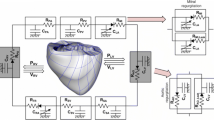Abstract
Left ventricular function was studied in six quadriplegic subjects by M-mode echocardiography with respect to cardiac material mechanics. Myocardial wall deformation and ventricular viscoelastic compliance were studied during systole and diastole. The left ventricle was assumed to be a sphere and to keep this shape over the cardiac cycle. The viscoelastic properties were determined with respect to the mid-wall. The haemodynamic results indicated that the ejection fraction of quadriplegics was significantly greater than in normals but that their cardiac output was significantly lower. The ratio of viscous compliance coefficient to elastic compliance coefficient was called the system time constant. The myocardial material results indicated that the inequality diastolic time constant ≤ systolic time constant was satisfied in the six quadriplegics. The ratio of end-systolic to end-diastolic wall area was significantly greater in quadriplegics than in normals. These results were consistent with the left ventricle of quadriplegics being deconditioned so that the ventricular wall is more compliant during systole and myocardial wall deformation is greater.
Similar content being viewed by others
Abbreviations
- AR ϕ :
-
left ventricular longitudinal cross-sectional area ratio, dimensionless
- AR ES :
-
AR ϕ at end-systole
- AR max :
-
maximumAR ϕ during a cardiac cycle
- M :
-
left ventricular internal diameter (LVID), cm
- V CF :
-
mid-wall circumferential fibre velocity, lengths s−1
- V CFD :
-
value of diastolicV CF at\(\hat t_D \), lengths s−1
- V CFS :
-
value of systolicV CF at\(\hat t_S \), lengths s−1
- W :
-
left ventricular wall thickness (LVWTh), cm
- A ϕ :
-
longitudinal face area of a unit element at the left ventricular equator, cm2
- A ϕD :
-
end-diastolicA ϕ, cm2
- δA ϕ :
-
infinitesimal change inA ϕ, cm2
- δθ:
-
small angle that subtendsA ϕ, rad
- R :
-
radius of curvature of the endocardial wall at the left ventricular equator, cm
- δθ D :
-
end-diastolic δθ, rad
- l :
-
a depth (thickness) into the myocardial wall as measured from the endocardial surface, cm
- dl :
-
infinitesimal change inl, cm
- t D :
-
time during the cardiac diastolic interval, s
- \(\hat t_D \) :
-
point in diastolic time at which σ1 = σ2, s
- t s :
-
time during the cardiac systolic interval, s
- \(\hat t_S \) :
-
point in systolic time at which σ1 = σ2, s
- ε:
-
mid-wall circumferential fibre strain, dimensionless
- εD :
-
ε at\(\hat t_D \), dimensionless
- εS :
-
ε at\(\hat t_S \), dimensionless
- η:
-
coefficient of viscous compliance, N s m−2
- μ:
-
coefficient of elastic compliance, N m−2
- σ:
-
total left ventricular mid-wall circumferential fibre stress, N m−2
- σ1 :
-
component of σ attributable to the elastic element, N m−2
- σ2 :
-
component of σ attributable to the viscous element, N m−2
- τ:
-
mid-wall circumferential fibre system time constant, s
- τD :
-
diastolic τ, s
- τS :
-
systolic τ, s
- τπ :
-
relaxation time for constant stress, s
- D :
-
end-diastolic value
- S :
-
end-systolic value
References
Danopulos, D. M., Kezdi, P., Stanley, E. L., Petrofsky, J. S., Phillips, C. A. andMeyer, L. S. (1985) Cardiovascular circulatory dynamics in subjects with chronic cervical spinal cord injury in supine and head up tilt position.J. Neuro. Ortho. Med. Surg.,6, 265–270.
Dodge, H. T. andBaxley, W. A. (1969) Left ventricular volume and mass and their significance in heart disease.Am. J. Cardiol.,23, 528–537.
Doeblin, E. O. (1962)Dynamic analysis and feedback control. McGraw-Hill, New York.
Feigenbaum, H. (1976)Echocardiography, 2nd edn. Lea & Febiger, Philadelphia, Pennsylvania.
Fung, Y. C. (1981)Biomechanics: mechanical properties of living tissues. Springer-Verlag, New York.
Ghista, D. N., Jayaraman, G. andSandler, H. (1978) Analysis for the non-invasive determination of arterial properties and for the transcutaneous continuous monitoring of arterial blood pressure.Med. & Biol. Eng. & Comput.,16, 715–726.
Guttman, L. (1976)Spinal cord injuries: comprehensive management and research, 2nd edn. Blackwell Scientific, Oxford, UK.
Hill, A. V. (1938) Heat of shortening and dynamic constants of muscle.Proc. R. Soc. Ser. B.,126, 136–152.
Mack, C. (1967)Essentials of statistics. Plenum Press, New York.
Mazumdar, J., Hearn, T. andGhista, D. N. (1980) Determination ofin-vivo constitutive properties and normal-pathogenic states of mitral valve leaflets and left ventricular myocardium from phonocardiographic data. InApplied physiological mechanics.Ghista, D. N. (Ed.), Harwood Academic Press.
Mirsky, I. (1976) Assessment of passive elastic stiffness of cardiac muscle.Prog. Cardiovasc. Dis.,18, 277–308.
Petrofsky, J. S. andPhillips, C. A. (1984) The use of functional electrical stimulation for rehabilitation of spinal cord injured patients.CNS Trauma J.,1, 57–72.
Phillips, C. A. (1977) The velocity-strain relationship: application in normal and abnormal left ventricular function.Ann. Biomed. Eng.,5, 329–342.
Phillips, C. A., Grood, E. S., Mates, R. E. andFalsetti, H. L. (1978) Left ventricular function: correlation with deformation of the myocardium.J. Biomech. Eng.,100, 99–104.
Phillips, C. A. andPetrofsky, J. S. (1981) An echocardiographic study of myocardial wall deformation in left ventricular pressure overload.J. Clin. Eng.,6, 213–218.
Phillips, C. A. andPetrofsky, J. S. (1982) An echocardiographic study of the velocity-strain relationship in coronary artery disease. Ibid.J. Clin. Eng.,7, 123–130.
Phillips, C. A. andPetrofsky, J. S. (1983) Cardiac material mechanics: the non-invasive analysis of myocardial material properties. InMechanics of skeletal and cardiac muscle.Phillips, C. A. andPetrofsky, J. S. (Eds.), Charles C. Thomas, Springfield, Illinois, 274–301.
Phillips, C. A. andPetrofsky, J. S. (1984) Myocardial material mechanics: characteristic variation of the circumferential and longitudinal systolic moduli in left ventricular dysfunction.J. Biomech.,17, 561–568.
Author information
Authors and Affiliations
Rights and permissions
About this article
Cite this article
Phillips, C.A., Danopulos, D.M. & Kezdi, P. Noninvasive cardiac material mechanics: Application to left ventricular function in quadriplegia. Med. Biol. Eng. Comput. 26, 333–341 (1988). https://doi.org/10.1007/BF02442288
Received:
Accepted:
Issue Date:
DOI: https://doi.org/10.1007/BF02442288




